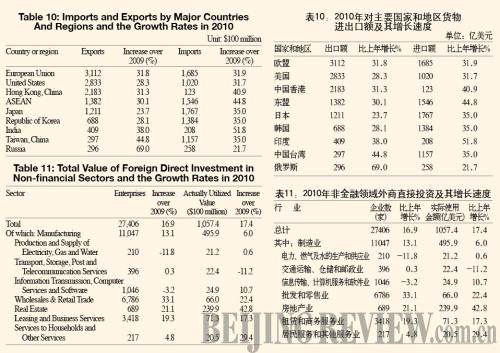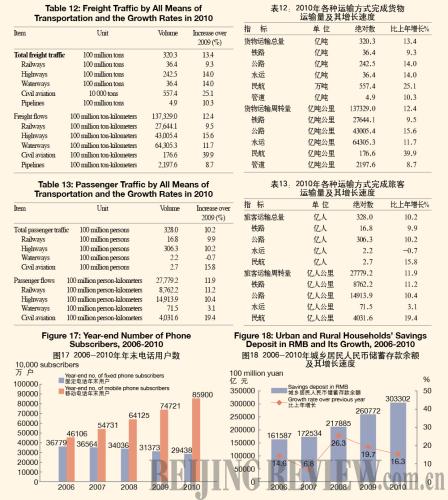|

At the end of 2010, there were 2,515 art-performing groups, 2,141 museums, 2,860 public libraries, 3,258 culture centers, 227 radio broadcasting stations, 247 television stations, 2,120 radio broadcasting and television stations and 44 educational television stations in the cultural system throughout China. Subscribers to cable television programs numbered 187.30 million. Subscribers to digital cable television programs were 87.98 million. Radio broadcasting and television broadcasting coverage rates were 96.8 percent and 97.6 percent respectively. Totally, 14,685 episodes of 436 TV series and 221,456 minutes of animated TV series[14] were made in 2010. The country produced 526 feature movies and 95 science, educational, documentary, cartoon and special movies. A total of 44.8 billion copies of newspapers and 3.2 billion copies of magazines were issued, and 7.4 billion copies of books published. By the end of the year, there were 4,077 archives in China and 90.35 million documents were made accessible to the public.
In 2010, Chinese athletes won 108 world championships on 22 sports events. Eight athletes and five teams broke 15 world records on 15 occasions. On the 16th Asian Games, China won 199 gold medals, 119 silver medals and 98 bronze medals, totaled 416 medals. On the Asian Para Games, China won 185 gold medals, 118 silver medals and 88 bronze medals, totaled 391 medals.
China hosted the World Expo for the first time. The Shanghai World Expo lasted 184 days with 246 countries and international organizations participated in it. Of this total, 190 were countries and 56 were international organizations. All the 31 provinces (autonomous regions and municipalities) and Hong Kong, Macao and Taiwan participated in it. The accumulative number of visitors reached 73.08 million.
X. Public Health and Social Services
By the end of 2010, there were 939,000 health institutions[15] in China, including 60,000 general hospitals and health centers, 31,000 community health service centers, 174,000 clinics, 651,000 village clinics, 3,491 epidemic disease prevention centers and 2,851 health monitoring institutions. There were 5.84 million health workers in China, including 2.37 million practicing doctors and assistant practicing doctors and 2.05 million registered nurses. General hospitals and health centers in China possessed 4.37 million beds. The number of rural health care centers was 38,000, possessing 1 million beds and employing 964,000 health care workers. In 2010, 3.414 million people were infected by A or B class infectious diseases, with 15,950 reported deaths. The incidence of infectious disease was 255.80 per 100,000, with the death rate standing at 1.20 per 100,000.
By the end of 2010, there were all together 40,000 social welfare institutions of various types providing 3.123 million beds, accommodating 2.365 million inmates. Of this total, 31,000 were rural elder-caring organizations providing 2.139 million beds, accommodating 1.704 million inmates. There were 180,000 community service facilities, of which there were 11,400 community service centers and 51,000 community service stations. Medical aid was provided to 3.736 million needy people in cities and 8.138 million needy people in rural areas. Another 12.374 million needy people in urban areas were financed to participate in urban medical insurance system, and 42.237 million needy people in rural areas were financed to participate in new type of rural cooperative medical care system.
XI. Population, Living Conditions And Social Security
According to preliminary estimation, at the end of 2010, the total number of Chinese population[16] reached 1,341.00 million.

In 2010, the annual per capita net income of rural households was 5,919 yuan, or a real increase of 10.9 percent over the previous year when the factors of price increase were deducted. The annual per capita disposable income of urban households was 19,109 yuan, or a real increase of 7.8 percent. The proportion of expenditure on food to the total expenditure of households was 41.1 percent for rural households and 35.7 percent for urban households. According to the 2010 rural poverty line with annual per capita net income below 1,274 yuan, the population in poverty in rural areas numbered 26.88 million at the end of the year, or 9.09 million less than that at the and of 2009.

At the end of 2010, a total of 256.73 million people participated in basic pension program, a year-on-year increase of 21.23 million. Of this total, 193.74 million were staff and workers, and 62.99 million were retirees. A total of 432.06 million people participated in urban basic health insurance program[17], an increase of 30.59 million, of whom 237.34 million people participated in urban basic health insurance program for staff and workers, 194.72 million people participated in programs for residents. A total of 45.83 million people participated in urban health insurance programs were migrant workers coming from the rural areas, an increase of 2.49 million. Some 133.76 million people participated in unemployment insurance programs, an increase of 6.60 million. A total of 161.73 million people participated in work accident insurance, an increase of 12.78 million, of which 63.29 million were migrant workers coming from the rural areas, an increase of 7.41 million. A total of 123.06 million people participated in maternity insurance programs, an increase of 14.30 million. A total of 2,678 counties (cities, districts) conducted the new cooperative medical care system in rural areas, with a participation rate of 96.3 percent. The total expenditure of the new cooperative medical care system in rural areas reached 83.2 billion yuan, benefiting 700 million people. In the pilot areas of new rural social pension insurance, some 102.77 million people participated in insurance program. The number of people receiving unemployment insurance payment stood at 2.09 million in 2010.
A total of 23.111 million urban residents received the government minimum living allowances, or 345,000 less than the previous year. About 52.284 million rural residents received the government minimum living allowance, an increase of 4.684 million, and 5.549 million rural residents received government five-guarantee relief[18], an increase of 15,000.
XII. Resources, Environment and Work Safety
In 2010, the total supply of state-owned land for construction[19] use was 428,000 hectares, a growth of 18.4 percent over the previous year. Of this total, that for mining storage, 153,000 hectares, up 7.9 percent; for commercial service, 39,000 hectares, up 40.4 percent; for residence, 114,000 hectares, up 40.3 percent; for infrastructure facilities, 122,000 hectares, up 10.2 percent. In 2010, of the total 105 key cities covered by monitoring program the composite prices for land[20] went up by 8.6 percent over the previous year, of which, the prices for commercial used land went up by 10.0 percent, for residential land, up 11.0 percent and 5.3 percent growth for industrial used land.
|
